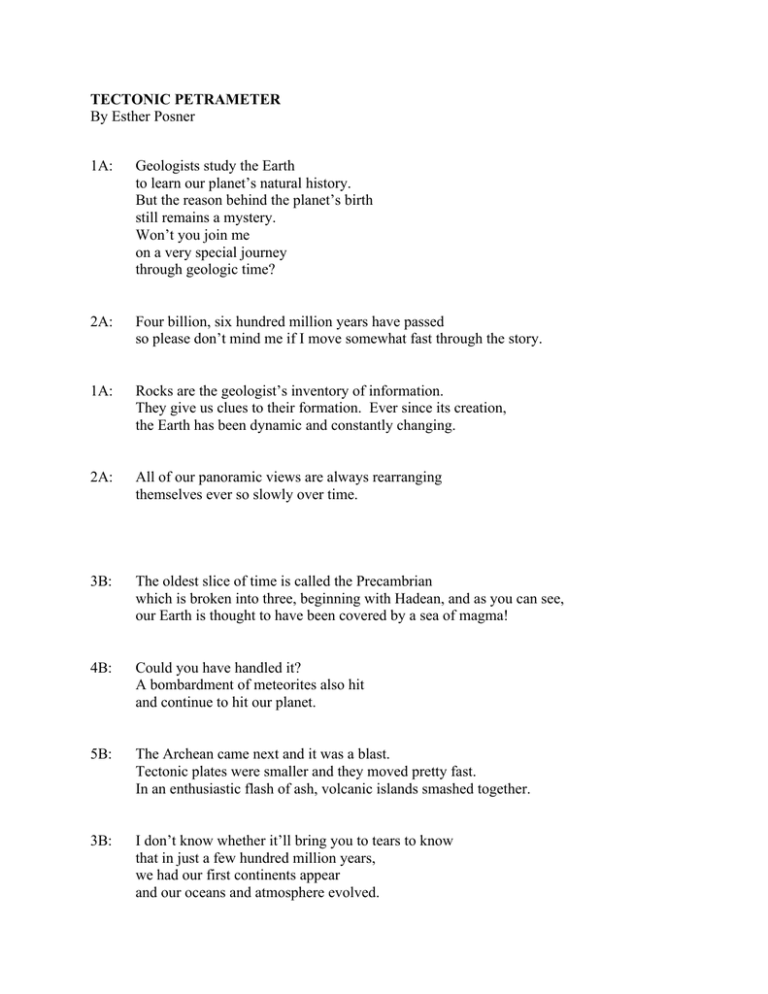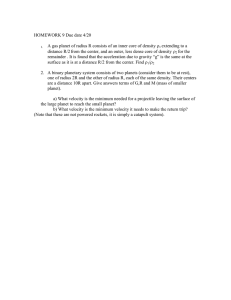
TECTONIC PETRAMETER
By Esther Posner
1A:
Geologists study the Earth
to learn our planet’s natural history.
But the reason behind the planet’s birth
still remains a mystery.
Won’t you join me
on a very special journey
through geologic time?
2A:
Four billion, six hundred million years have passed
so please don’t mind me if I move somewhat fast through the story.
1A:
Rocks are the geologist’s inventory of information.
They give us clues to their formation. Ever since its creation,
the Earth has been dynamic and constantly changing.
2A:
All of our panoramic views are always rearranging
themselves ever so slowly over time.
3B:
The oldest slice of time is called the Precambrian
which is broken into three, beginning with Hadean, and as you can see,
our Earth is thought to have been covered by a sea of magma!
4B:
Could you have handled it?
A bombardment of meteorites also hit
and continue to hit our planet.
5B:
The Archean came next and it was a blast.
Tectonic plates were smaller and they moved pretty fast.
In an enthusiastic flash of ash, volcanic islands smashed together.
3B:
I don’t know whether it’ll bring you to tears to know
that in just a few hundred million years,
we had our first continents appear
and our oceans and atmosphere evolved.
4B:
Acidic iron, which used to dissolve, reacted with oxygen
that stromatolites resolved to release.
5B:
Say that six times fast – or six hundred million times slow!
TIME is what matters as through geologic time we go.
6C:
The last third of the Precambrian is called the Proterozoic,
which means ‘before life,’ but now we know it is not true
because early Earth creatures occupied the ocean blue.
7C:
But there was no life on land, no plants or trees,
so the brisk breezes and bleak rains
drained the land of its debris.
6C:
And although it may seem ironic, tectonic forces
broke apart and set micro-continents onto separate courses
that would collide and divide again and again.
7C:
Our friend, the Earth, is always changing
and rearranging its crust.
8D:
It must have been a strange sensation
for the Earth to experience a global glaciation.
9D:
A planet of ice! A real snowball Earth!
8D:
But it may have been this climate catastrophe which eventually gave birth
to complex critters who began to grow once the snow began to go away.
9D:
After three billion years of single-cellular life,
multi-cellular life was here to stay!
8D:
Sometimes more than other times…
10E:
KABOOM!!!
11E:
Did you hear that?!
12E:
It sounded like an explosion!
10E:
Life in the Cambrian was filled with multi-cellular motion.
11E:
We now enter the notion of time
that is called the Paleozoic – and what a stoic time.
12E:
Shelly sea life occupied the oceans
and trilobites were in their prime.
10E:
In came the seas and drowned up lots of land
and even Michigan was underwater
and didn’t look much like a hand.
13F:
In the Ordovician, the seas may have seemed interesting for fishing,
14F:
but the most important event which began to expand
was the emergence of plants and mold on the land.
13F:
Life still flourished in the serene waters
and marine parents probably cautioned their sons and their daughters,
“Kids, stay away from the squids.”
14F:
Quite forbidding were the cephalopods, ancestors of octopi,
who terrorized the trilobites who were living nearby.
13F:
And all I can say, with a heavy sigh,
about the end of the Ordovician day
is that almost everything would die.
15G: Although somewhat covered by frost,
all life was not lost.
And without too much grief,
the Silurian boomed with reefs.
16G: Corals like colonies
spread throughout the seas
including our friendly Hexagonaria,
commonly called Petoskey1.
15G: A topical reference
for Earth’s geographic change
is this coral’s tropical preference,
which means that Michigan was latitudinally rearranged!
16G: Warm waters flowing below the equator,
in paradise if you please,
while the land was slowly filling with trees.
15G: This was new!
Vascular plants made their biologic debut
and fish with jaws joined the sea life stew.
17H: Now if you visit the Smithsonian stage,
you’ll see fish fossils of Devonian age
for the Devonian was the Age of Fish.
18H: Don’t you wish you could have a dish of that fish?!
17H: Some had vertebras the size of flagpoles
while sharp-toothed sharks patrolled.
1
Author’s note: The “Petoskey” is Michigan’s state stone – but it’s actually a coral fossil!
18H: Coal was just beginning to form on land
as plant life continued to expand
and even the fish began to stand!
17H: Amphibians appeared queerly
and in their growth roamed both
the sea and the land.2
19I:
Now it’s time to get down with the Coal Swamp Stomp!
Tap your feet to the beat of the formation of peat
like a plant plantation soaking up the bright heat.
20I:
Earth’s two massive continents began to creep
their massive way into each other
to form what today we say was Pangaea.
19I:
An important idea to keep in mind
is that Earth’s crust, climate, and chemistry
change slowly over long periods of time.
20I:
This is what rocks tell us,
and sometimes in rhyme.
1J:
The Permian Period is the final chapter
in the myriad of curious details from the Paleozoic – and what a stoic time.
2J:
Pangaea was in full form
and environments were transforming,
1J:
informing its living inhabitants
of an upcoming storm.
2
Author’s note: The word queerly is used in a purely non-derogatory way as in the traditional definition of the word
meaning strangely or oddly.
2J:
96% of all life ended up succumbing to it – but don’t be too forlorn.
Life would certainly be reborn in a brand new form.
3K:
Following the distinctly disturbing extinction of Permian life,
the rebirth of the Triassic seemed enthusiastically fantastic.
4K:
In fact, the Mesozoic was quite heroic for all the reptile fans
as dinosaurs began to span the grand land mass.
5K:
But alas, Pangaea would break and move some more
and brand new oceans formed their mafic floor.
3K:
Did anyone hear the roar of that shrew?
4K:
Our planet’s first mammals made their hairy debut
in the terrific Triassic.
5K:
Now when I say Jurassic, you think Jurassic Park.
But let’s embark a little deeper
and shed some light into this dark.
3K:
Birds first flew in the skies above
and frogs and salamanders also made their debut shove.
4K:
Just like a glove, the coasts of Africa and South America fit perfectly
and in the Jurassic, this land mass began to break itself free
5K:
forming a narrow but expanding sea
that would eventually be
the Atlantic Ocean. Blessed be.
6L:
The Cretaceous was sensateous
with a chalky aftertaste.
7L:
We can learn a lot
from the dinosaur bones encased in rock
as Earth’s clock ticks on and on,
6L:
as life continues to be drawn to spawn until everything’s gone.
Hey, don’t yawn at the writing on the wall!
7L:
An exciting mass extinction is so enthralling!
6L:
All in all, destiny may be stalling the final blow
7L:
but at the end of the Cretaceous,
as we’re beginning to know
and act more philosophic about,
an impact and catastrophic route
caused the Earth to react.
6L:
And the fact of the matter is the matter of fact.
Dinosaurs eventually died out and they never came back.
8M:
But have no fear!
That mass extinction occurred 65 million years ago
and so much continues to slowly change;
it’s holy yet strange.
9M:
The Cenozoic heroically introduced
the Age of Mammals, which gave a boost
to the existence of us.
8M:
Can you believe that we have barely discussed us?
9M:
Earth history is just so long!
8M:
It’s so much more than this song’s rhyming refrain can contain.
9M:
It’s not even within the scope of a professional telescope.
8M:
Its worth is beyond the range of the New York Stock Exchange
9M:
and things just keep changing and changing
and all so slowly rearranging over time.
8M:
It’s more than enough to blow your mind!
9M:
It’s the stuff that fills the deepest geologic time.
10N: It’s the climbing to the top of the mountain peak
and stopping to catch your breath
11N: but before you can speak,
erosion has erased the mountain to the ocean’s deep.
12N: And it’s all about scale and without fail,
CHANGE is the Earth’s constant prevailing force,
which provides for interesting discourse, of course.
10N: But we still don’t know the source of this cosmic sorcery
or just exactly what it means to be alive
and to be free, to feel and to be.
11N: It’s a mystery but we can learn a lot from history.
12N: Like in the Pleistocene, beginning 1.8 million years ago,
much of the Northern Hemisphere was covered by glacial snow.
10N: And I mean an ocean of ice,
which shaped our landscape up real nice
11N: and filled our valleys with various types of rocks,
which geologists consider to be the Earth’s natural ticking clock.
13O: It shouldn’t stop so don’t worry about hurrying it up
and be sure to avoid those Styrofoam cups.
14O: It makes a difference what we consume
so please don’t assume that the Earth was created just for you.
13O: Just coexist with Nature and that should do. That should do.
14O: We are brewing up our knowledge
and filling colleges with folks
who acknowledge the importance
of our granite-bearing planet.
13O: Can you stand it as you stand on it?
15P:
It’s micro, it’s macro,
it’s quantum and fun.
16P:
It’s exciting and living
thanks to radioactivity and the Sun.
15P:
Has the story only begun?
And are we the only ones?
16P:
The universe doesn’t really seem that lonely or secluded,
but the human quest for knowledge is hardly concluded.
17Q: And now it’s our turn,
this generation-tech,
to build on the foundation of our foreparents’ track.
18Q: Understanding the difference between black and gray…
and sometimes you’ve got to just call it a day.
17Q: But the Earth will go on,
beyond our tears and our fun.
18Q: It’s so much better than any rerun on T.V.,
it’s the story of our planet’s ancestry.
19R:
Geology is a great study for girls and boys
20R:
who enjoy the joy of the Earth’s worth
19R:
and place in this universe of space.
20R:
The pace of the race for knowledge
is all dependent upon the scale.
19R:
But if you start to follow your heart,
you’ll get smart and never fail.
20R:
And if you fail, just try again
with the new insight you have gained
19R:
and hold on tight to life’s sweet flight
because so much still waits to be explained.
Esther Posner is an award-winning performance poet and graduate student in the Department of
Geosciences at the University of Arizona. She performs “Tectonic Petrameter” from memory
with a vividly illustrated PowerPoint presentation in a powerful, hilarious, and truly
unforgettable fusion of art and science. Posner is available for educational and inspirational
performances (including additional science and math poetry and music) upon coordination by a
host institution.
Contact: posnere@email.arizona.edu for more information.
Copyright © 2011 All Rights Reserved.








